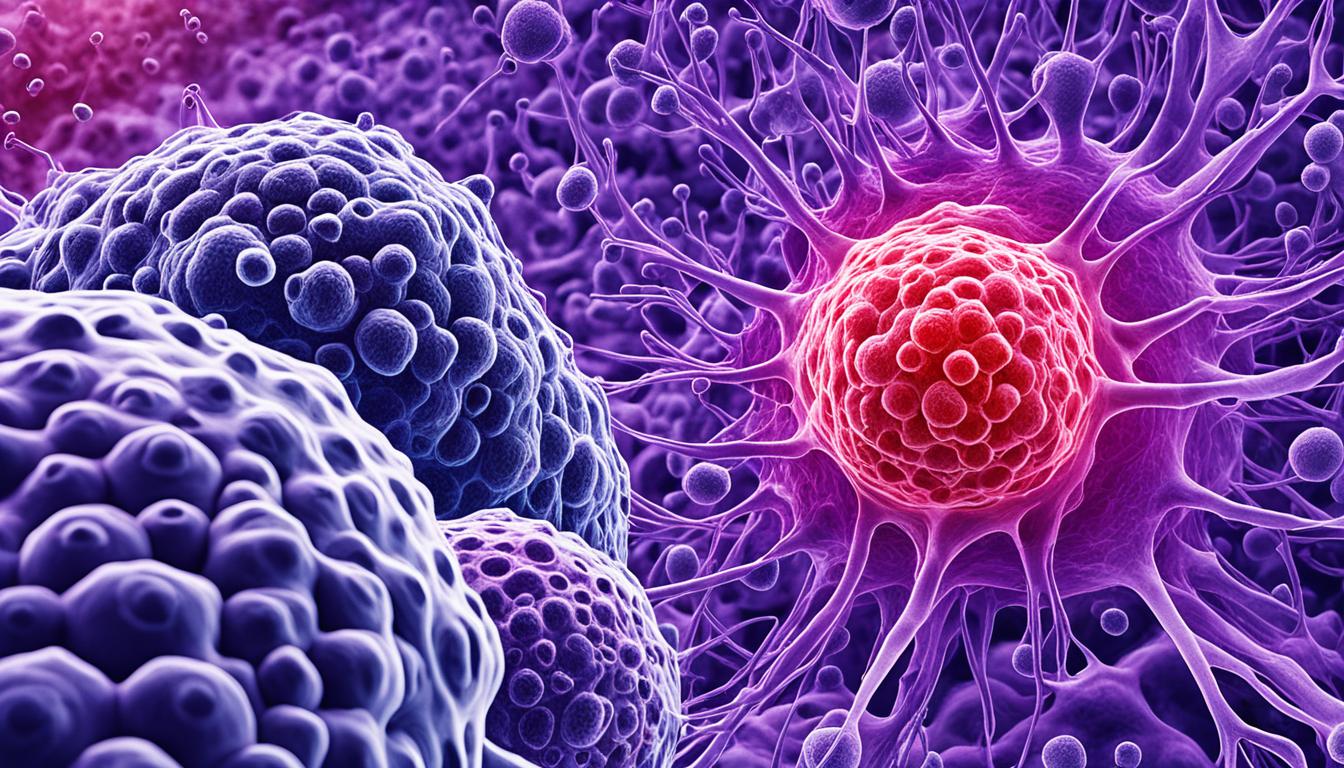Oxyphil cell carcinoma is a rare thyroid cancer. It originates from follicular cells in the thyroid gland. Large eosinophilic cells with abundant mitochondria characterize it.
This rare thyroid cancer accounts for a small percentage. It is more common in older individuals, regardless of gender.
Key Takeaways
- Oxyphil cell carcinoma is a rare thyroid cancer type.
- It has large, oxyphilic cells with abundant mitochondria.
- It’s a rare, aggressive follicular thyroid carcinoma subtype.
- Symptoms may include thyroid mass, dysphagia, hoarseness, breathing difficulty.
- Diagnosis involves biopsy, imaging studies, and histopathological analysis.
Understanding Oxyphil Cell Carcinoma
Oxyphil cell carcinoma is a rare subtype of follicular thyroid cancer. It’s characterized by large cells with abundant mitochondria in the cytoplasm. These cells come from thyroid gland’s follicular cells.
They have unique morphological and functional traits. The cancer cells are large and eosinophilic (oxyphilic) with high mitochondrial content.
Defining Oxyphil Cell Carcinoma
This rare and aggressive thyroid cancer variant has large eosinophilic cells. These Hürthle cells or oncocytes are derived from follicular thyroid cells.
Their cytoplasm and nuclei differ from common follicular cells. The cells have high mitochondrial presence, giving them distinct features.
Epidemiology and Risk Factors
Oxyphil cell carcinoma accounts for less than 5% of thyroid cancers. It’s more common in older adults, median age 60-70 years.
No clear gender bias exists. Risk factors include childhood radiation exposure to head/neck region. Family history of thyroid disorders also elevates risk.
Histological and Molecular Characteristics
Histologically, it has large eosinophilic cells with granular oncocytic cytoplasm. The cells have round, centrally located nuclei and abundant mitochondria.
Molecularly, NRAS and TP53 gene mutations occur. These influence tumor behavior and treatment response.
Oxyphil Cell Carcinoma: Clinical Presentation and Diagnosis
Oxyphil cell carcinoma may present with a noticeable thyroid mass or nodule. Symptoms like difficulty swallowing, hoarseness, or breathing issues may occur due to surrounding structure compression. However, some cases are asymptomatic and discovered incidentally.
Diagnostic Modalities
Accurate oxyphil cell carcinoma diagnosis requires a comprehensive approach involving:
- Physical examination: Palpating the thyroid for masses or nodules.
- Imaging: Ultrasonography, CT, or MRI for lesion assessment.
- Fine-needle aspiration biopsy (FNAB): Obtaining cells from the nodule.
- Thyroid function tests: Measuring hormone levels.
Differential Diagnosis
Distinguishing oxyphil cell carcinoma from other thyroid neoplasms like follicular, papillary carcinomas, or benign lesions is crucial. The differential diagnosis utilizes clinical, radiological, histological features, and sometimes molecular genetic analysis.
Conclusion
In summary, oxyphil cell carcinoma is a rare, aggressive thyroid cancer subtype. It features large, eosinophilic cells with abundant mitochondria. This uncommon cancer accounts for few thyroid malignancies.
While rare, understanding oxyphil cell carcinoma’s clinical presentation, diagnosis, and management strategies is vital for healthcare professionals. Early detection, accurate diagnosis, and appropriate treatment can significantly improve patient outcomes.
Ongoing research into molecular profiling and targeted therapies for rare thyroid cancers like oxyphil cell carcinoma holds promise for enhancing management and outcomes. Efforts to raise awareness, improve diagnostics, and optimize treatment strategies remain crucial.

